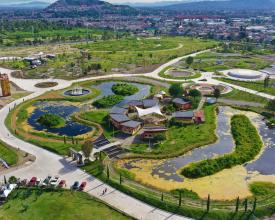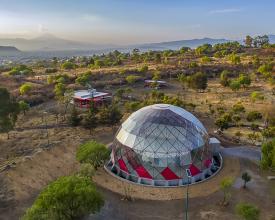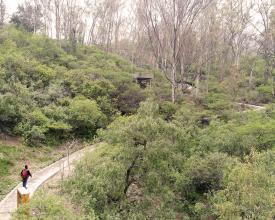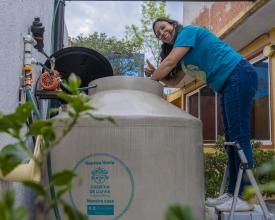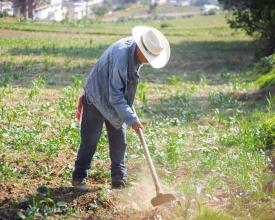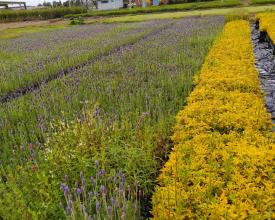
Mexico City's Environmental and Climate Change Program: revegetation of the countryside and the city

Mexico City has grown in a disproportionate manner, deteriorating nature and resulting in a polluted city, disconnected from nature, with inequalities and vulnerable to climate change. To counteract this, the Environmental and Climate Change Program (PACC) of Mexico City 2019-2024 has been implemented, which has allowed us to improve ecological conditions and reduce environmental impacts, as well as adopt measures to adapt to climate change. The PACC is integrated by 7 axes: revegetation, rescue of rivers and water bodies, sustainable water management, zero waste, integrated and sustainable mobility, air quality and solar city. The implementation of the PACC has involved carrying out different programs, such as Reto Verde, Sembrando Parques, Programa Altépetl, Programa Especial de la Red de Infraestructura Verde (PERIVE), Jardines para la Vida and Cosecha de Agua de Lluvia (Rainwater Harvesting).
Context
Challenges addressed
Environmental
Challenge: Implement ecosystem-based adaptation measures through the restoration of natural areas.
Solution: Implementation of the Green Infrastructure Program (PERIVE), through which plant communities are regenerated, new wetlands are recovered and created, and rivers are restored.
Social
Challenge: Improve distribution and access to biodiversity benefits.
Solution: Investment in programs such as Gardens for Life and Rain Harvest, which strengthen the community and build capacity to protect and sustainably use biodiversity and water resources, with a gender focus.
Economic
Challenge: Ensure that productive activities integrate biodiversity conservation and sustainable use criteria into their processes.
Solution: Reactivate the use of 5 thousand hectares of land for agroecological production practices, including reestablishing the use of chinampas. Promote trade in sustainable production, which has generated an economic spillover of more than $400 million.
Location
Process
Summary of the process
Strengthening the legal framework and public policy | Governance and intersectoral coordination, allowed us to lay the foundations for transforming the city. The need to change the approach to have a systemic, comprehensive and rights-based vision, which would lead to the implementation of policies, programs and strategies that were complementary and that did not discard social and economic factors, so it was necessary to consider a human rights and social justice approach to reduce inequalities through the recovery of natural spaces guaranteeing the right to a healthy environment, using strategies under the approaches of Solutions based on Nature (SbN) and Adaptation based on Ecosystems (AbE).
Building Blocks
Strengthening the legal framework and public policy | Governance and cross-sectoral coordination
The perspective on how to address the environmental problems facing the city was modified, integrating the following principles:
- Improve accessibility to natural spaces and the distribution of environmental benefits, prioritizing areas of the city with high marginalization and vulnerability.
- Prioritize social participation and people whose livelihoods depend on nature.
- Increase investment in environmental restoration.
As well as strengthening legal frameworks, such as in the Political Constitution of the CDMX where investment in conservation land is guaranteed; the modification to the Environmental Law for the Protection of the Land of Mexico City, where the term biodiversity is considered in its provisions; the adoption of the Law for Mitigation and Adaptation to Climate Change and Sustainable Development of Mexico City and the Law of Circular Economy.In addition to the Environmental Climate Change Program, strategies and action plans were developed in a participatory manner to articulate public policies to address climate change and conserve biodiversity. The planning and execution of these instruments has involved the participation and coordination of multiple sectors in addition to the environmental sector and citizen participation, taking into account the generation of environmental, social and economic benefits.
Enabling factors
Communication with other government agencies in sectors other than the environmental sector. This allows for inter-institutional collaboration, a broader and more comprehensive vision of the needs, knowledge and capabilities required, as well as support among those who collaborate according to their attributions.
Lesson learned
It is important to be clear about the attributions of each institution, especially of sectors other than the environmental sector, in order to recognize their role in Mexico City and thus improve coordination actions in the implementation of comprehensive programs such as PERIVE, and to hold workshops or working groups to raise awareness and present the interests and points of view of each sector.
Human rights and social justice approach
The programs integrate a vision of rights and environmental justice. This involves working to reduce inequalities, integrating nature in and around our city, for which we worked with a Nature-based Solutions (NBS) approach in different areas of the city, recovering natural spaces and restoring them for the benefit of the population, improving and increasing access to nature and ecosystem services.
In order to address social challenges and support human well-being, through the Altépetl Program, we support producers with economic aid, technical assistance and training to promote agroecological practices, sustainable production systems that integrate and protect biodiversity at the local level, and short marketing chains. On the other hand, by improving public spaces through the improvement or creation of green and blue areas, the public has been able to take ownership of public spaces, improving safety, mainly in areas of high marginalization and vulnerability. Additionally, through the Women Pollinators program, women have been trained as leaders in the creation of pollinator gardens, reinforcing the society-nature relationship and making visible the work of women as a pillar in the social structure; and through the Rainwater Harvesting program, rainwater harvesting systems are installed, distributing in a fairer and more equitable manner the work of water provision, which generally falls on women.
Enabling factors
- Through 'Peasant Learning Communities', 40 thousand people have been trained to improve productive schemes; the area of sustainable use has increased, using agroecological practices that protect biodiversity; and the commercialization of sustainable products is being promoted.
- Capacity building for community organization in the establishment of pollinator gardens and rainwater harvesting systems.
- The objective of the Rainwater Harvesting program is to reduce inequalities in access to water, increase resilience to occasional supply crises and contribute to closing gender gaps that affect women, who are often assigned the task of fetching water to cover basic household needs.
Lesson learned
The excessive growth of the human population and uncontrolled urbanization have given rise to a myriad of serious environmental consequences, coupled with the climate crisis, and the only way to solve and stop the damage is to change the way we deal with it, taking into account the integration of social and economic aspects. Environmental damage contributes to the widening of the social gap, generating a vicious cycle of greater environmental damage, less available resources, greater scarcity, more poverty. Breaking this cycle requires the implementation of systemic solutions; there can be no conservation and restoration efforts with the long term in mind without considering the benefits to society and capacity building.
Resources
Nature Restoration and Regeneration: Ecosystem-based Adaptation (EbA)
The Environmental and Climate Change Program, through its axes revegetation and rescue of rivers and water bodies, directly contemplates Ecosystem-based Adaptation (EbA) actions, since revegetation implies contributing to the regeneration of the city's own nature: revaluing and using native species, revegetation with different strata to regenerate resilient plant communities; rehabilitating, conserving and restoring water bodies and their associated biodiversity; restoring soil fertility and promoting technologies such as technosols that allow water infiltration, integrating the principles of circularity, since they are developed based on waste such as PET and silt from dredging; as well as promoting technologies that allow the integrated management of vegetation pests and diseases. This makes it possible to address the effects of climate change, since the recovery of vegetation cover and the presence of wetlands act as buffers against extreme weather. It also improves the connectivity of natural spaces in the city to increase the available habitat for flora and wildlife, reestablishing the components of ecosystems and their resilience.
Enabling factors
- Know the composition and function of the plant communities that originally inhabited the spaces.
- Recognize the importance of water resilience and the factors that enable it, such as the conservation of ecosystems that recharge the aquifer, springs and rivers that provide water to the city, and maintain and improve the interconnection between the city's green and blue infrastructure.
- To have the necessary management to make use of public spaces for the recreation of plant communities outside the areas that are in conservation land.
- Environmental restoration and improvement of green areas adjacent to bodies of water.
- Promote technologies that allow for the integrated management of vegetation pests and diseases.
- Socialization and community awareness.
Lesson learned
Before starting any intervention, it is important to carry out campaigns and dissemination strategies on sustainable urbanism to promote a vision of a regenerative city among the city's inhabitants, as well as to disseminate information on the importance of native plants within plant communities and the impact they have on the maintenance of biodiversity and interactions with other living beings, which has a direct positive impact on ecosystem services. Knowledge gives citizens a better understanding of nature and can contribute to biodiversity conservation.
Resources
Impacts
In order to comply with the PACC and its 7 axes, the following has been carried out:
- Green Challenge, to revegetate and reforest the city. There are 44 million trees, shrubs, grasses and groundcovers that are greening the city.
- Productive improvement of Mexico City's nurseries, which went from an annual production of less than 500 thousand specimens in 2018 to more than 10.8 million in 2022.
- More than 30 km of riverbeds rehabilitated and without waste discharges.
- More than 722 ha of natural wetlands restored.
- "Altépetl" program created in 2019 to address conservation soil, benefiting more than 200 thousand people whose livelihoods depend on nature.
- "Sembrando Parques" Program, for the creation and rehabilitation of 18 large parks, totaling around 1,500 hectares intervened.
- Gardens for Life" program, which trained 979 women who lead the creation of pollinator gardens, creating 1,030 pollinator gardens.
- More than 63,000 Rain Harvesting Systems were installed.
All this linked to the Special Program of the Green Infrastructure Network of Mexico City (PERIVE), the Strategy for the Conservation and Sustainable Use of Biodiversity in Mexico City (ECUSBE) and its Action Plan 2030, and the Local Strategy and Climate Action Plan (ELAC and PACCM) of Mexico City 2030.
Beneficiaries
- Indirectly benefits the 9.2 million inhabitants of the CDMX.
- The "Altépetl" program benefits more than 200 thousand people who depend on nature.
- "Gardens for Life" trained 979 women.
- More than 63 thousand rain harvesting systems.
Sustainable Development Goals
Story
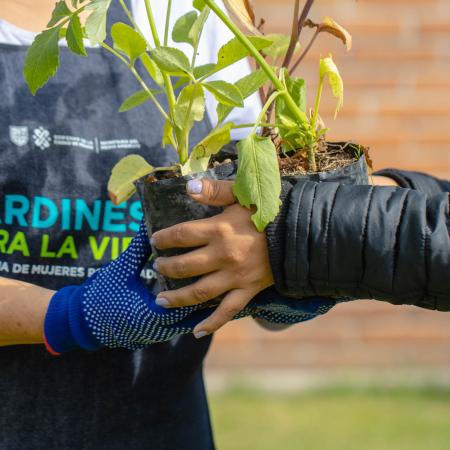
The Gardens for Life project seeks to promote the training of women in theoretical and practical knowledge of gardening and urban gardens, mainly in the creation of pollinator gardens. Through Gardens for Life, women learn not only to plant, but also to reconnect with nature, value it and recognize the benefits that plant-animal interaction provides to people and other living beings. This appropriation of knowledge and of nature itself, strengthens the commitment to the environment, leading people to seek a better quality of life through the creation and improvement of ecosystem services, in addition, among them arises the interest to share both knowledge and spaces and conditions for future generations. This is a clear example of the type of solutions we require to improve our environment, with a systemic approach and social justice, seeking to reduce inequalities.


